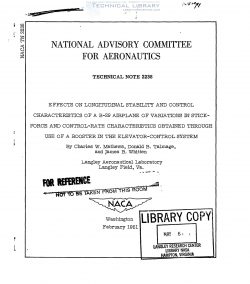naca-tn-2238
- Version
- 118 Downloads
- 1.22 MB File Size
- 1 File Count
- December 14, 2016 Create Date
- December 14, 2016 Last Updated
National Advisory Committee for Aeronautics, Technical Notes - Effects on Longitudinal Stability and Control Characteristics of a B-29 Airplane of Variations in Stick Force and Control Rate Characteristics Obtained Through Use of a Booster in the Elevator Control System

The longitudinal stability and control characteristics of a
B—29 airplane have been measured.with a booster incorporated in the
elevator-control system. Tests were made to determine the effects on
the handling qualities of the test airplane of variations in the pilot‘s
control—force gradients as well as the effects of variations in the
maximum rate of control motion supplied by the booster system.
The variations of elevator-control force with normal acceleration
for the test airplane without boost were about 90 pounds per g at an
indicated.airspeed of 160 miles per hour and about lhO pounds per g at
250 miles per hour. These'control forces were considered by the pilots
to be tolerable but heavy. Use of the booster to reduce these control—
force gradients by a factor of about 2.8 appreciably improved the control
characteristics of the test airplane. Reduction of the force gradients
by a factor of about h.6 through use of the booster also resulted in
satisfactory control characteristics in terms of the pilots' opinions
of their ability to control the airplane precisely in normal flight
maneuvers, although these force gradients were not so desirable as with
the boost ratio of 2.8. The effect of these lower force gradients on
the probability of exceeding the limit load factor could not be
investigated.
The results of the control-rate investigation indicate that large
airplanes may have satisfactory handling qualities with the booster
adjusted to give much lower rates of control motion than those normally
used by pilots. During landings of the test airplane, high rates of
control motion were used by the pilots both without the bodster and with
the booster operating under conditions where high control rates were
available from the system, but other landings, which were made with the
rate of elevator motion restricted to values as low as 7° per second,
were satisfactory from the standpoint_ of the pilots‘ opinions of the
handling qualities of the airplane.
There is a current trend to the use of booster systems for operating
the control surfaces of airplanes. The use of boosters results primarily
from a need for.alleviating the large control forces associated with
large airplanes, for improving the maneuvering capabilities of high—speed
fighter airplanes where control deflections are limited._by the physical
capabilities of pilots, and for improving the control- force characteristics
where the aerodynamic hinge moments of the--control surfaces have unsatis-
factory variations.
| File | Action |
|---|---|
| naca-tn-2238 Effects on Longitudinal Stability and Control Characteristics of a B-29 Airplane of Variations in Stick Force and.pdf | Download |

Comment On This Post